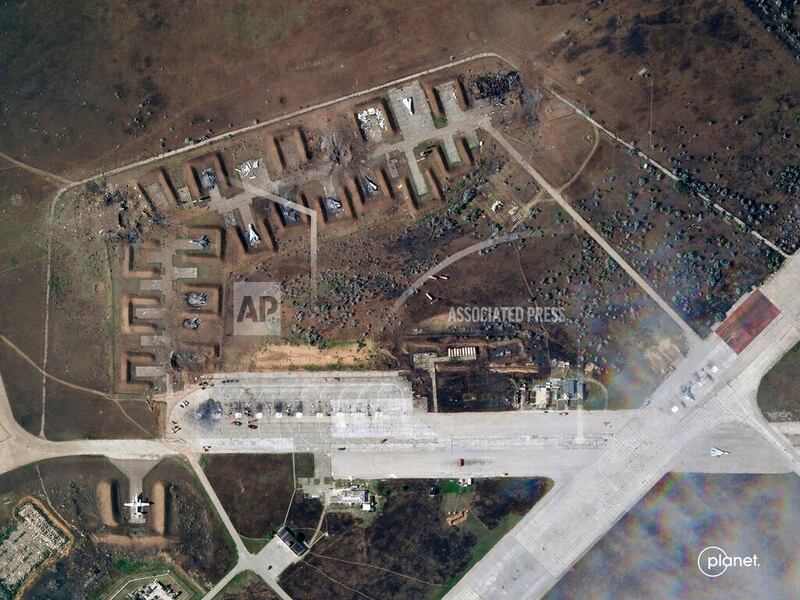Russia has blamed “sabotage” for the latest explosions at one of its military facilities in occupied Crimea, prompting the evacuation of thousands of local residents and adding to speculation over Ukraine’s apparent ability to strike targets far behind enemy lines.
Hours after the blasts began at the military warehouse in Dzhankoi in northern Crimea, Russian media said locals near the Gvardeyskoye air base further south on the peninsula were reporting hearing explosions and seeing smoke rising from the facility. There was no immediate confirmation of any incident at Gvardeyskoye from Russian officials.
“On the morning of August 16th, as a result of sabotage, a military warehouse near the village of Dzhankoi was damaged. A number of civilian facilities, including power lines, a power plant, a railway track, as well as a number of residential buildings, were damaged,” Russia’s defence ministry said in a statement.
[ Three reported killed in latest Russian shelling of eastern UkraineOpens in new window ]
Officials in Crimea, which Russia annexed from Ukraine in 2014, said two people were injured in the explosions and more than 3,000 people evacuated from nearby villages.
Moscow did not say who was responsible for the sabotage or how they caused the explosions, which also set fire to an electricity substation in Dzhankoi, prompting the suspension of rail traffic in an area that is a key supply route for Russian troops fighting in the partially occupied Kherson and Zaporizhzhia regions of southern Ukraine.
Russia blamed lax safety procedures for explosions at an airbase in Crimea last week and said no military hardware had been damaged. Satellite images subsequently showed that the blasts destroyed at least eight Russian warplanes on the tarmac, however.

Ukraine has welcomed the destruction of the Russian weapons and facilities while declining to take responsibility for the incidents, fuelling speculation over whether Kyiv’s military could be using covert sabotage units, precision missiles or long-range drones to extend into Crimea its efforts to attack supply lines used by the Kremlin’s invasion force.
“Morning near Dzhankoi began with explosions,” Mykhailo Podolyak, a senior adviser to Ukrainian president Volodymyr Zelenskiy, wrote on Twitter.
“A reminder: Crimea of normal country is about the Black Sea, mountains, recreation and tourism, but Crimea occupied by Russians is about warehouses explosions and high risk of death for invaders and thieves. Demilitarisation in action.”
Without referring explicitly to events in Crimea, Andriy Yermak, Mr Zelenskiy’s chief of staff, said on social media: “The Ukrainian armed forces continue the … ‘demilitarisation’ operation to fully rid our land of Russian invaders. Our soldiers are the best sponsors of a good mood. Crimea is Ukraine.”
Russia’s FSB security service said on Tuesday that Ukrainian “sabotage groups” had damaged electricity lines linked to the Kursk nuclear power plant on three occasions this month. Ukrainian operatives have also been accused of damaging other Russian infrastructure, including rail tracks and an oil refinery near the border between the states.
Moscow says it launched a full-scale invasion of Ukraine in February to protect its Russian speakers, to demilitarise and “denazify” the pro-western democracy, and to prevent it becoming a bridgehead for what the Kremlin claims were Nato plans to threaten Russia.
Thousands of civilians have died and millions have been displaced in fighting that is now focused in eastern Ukraine – where Russia is grinding forward extremely slowly – and in the southeastern Kherson and Zaporizhzhia regions, where Kyiv’s troops plan to launch a counterattack.
Ukraine and Russia accused each other again on Tuesday of firing artillery near the Zaporizhzhia atomic power station – the biggest in Europe – which is in territory seized by Moscow’s troops in March.
Mr Zelenskiy said he discussed the situation at the plant with French president Emmanuel Macron amid calls for international monitors to be allowed to visit the power station and assess the safety of its six nuclear reactors.










